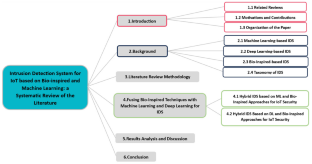Cluster Computing ( IF 4.4 ) Pub Date : 2024-04-14 , DOI: 10.1007/s10586-024-04388-5 Rafika Saadouni , Chirihane Gherbi , Zibouda Aliouat , Yasmine Harbi , Amina Khacha

|
Recent technological advancements have significantly expanded both networks and data, thereby introducing new forms of attacks that pose considerable challenges to intrusion detection and network security. With intruders deploying increasingly diverse attack vectors, the need for robust Intrusion Detection Systems (IDSes) has become paramount. IDS serves as a crucial tool for monitoring network traffic to uphold the integrity, confidentiality, and availability of systems. Despite the integration of Machine Learning (ML) and Deep Learning (DL) algorithms into IDS frameworks, achieving higher accuracy levels while minimizing false alarms remains a challenging task, especially when handling large datasets. In response to this challenge, researchers have turned to bio-inspired algorithms as potential solutions to enhance IDS models. This paper undertakes a comprehensive literature review focusing on augmenting the security of Internet of Things (IoT) networks by integrating bio-inspired methodologies with ML and DL techniques. Among 145 published articles, 25 relevant studies were selected to address the defined research objectives. The findings underscore the efficacy of combining bio-inspired techniques with ML and DL approaches in enhancing IDS performance, highlighting their potential to bolster IoT network security. Furthermore, the review incorporates a comparative analysis of the selected articles, considering various factors, and outlines ongoing challenges and future directions in integrating bio-inspired techniques with ML and DL algorithms.
中文翻译:

基于仿生和机器学习技术的物联网入侵检测系统:文献的系统回顾
最近的技术进步显着扩展了网络和数据,从而引入了新形式的攻击,给入侵检测和网络安全带来了巨大的挑战。随着入侵者部署的攻击媒介日益多样化,对强大的入侵检测系统 (IDS) 的需求变得至关重要。 IDS 是监控网络流量以维护系统完整性、机密性和可用性的重要工具。尽管机器学习 (ML) 和深度学习 (DL) 算法已集成到 IDS 框架中,但在最大限度地减少误报的同时实现更高的准确度仍然是一项具有挑战性的任务,尤其是在处理大型数据集时。为了应对这一挑战,研究人员转向仿生算法作为增强 IDS 模型的潜在解决方案。本文进行了全面的文献综述,重点关注通过将仿生方法与机器学习和深度学习技术相结合来增强物联网 (IoT) 网络的安全性。在 145 篇发表的文章中,选择了 25 篇相关研究来解决既定的研究目标。研究结果强调了将仿生技术与机器学习和深度学习方法相结合在增强 IDS 性能方面的功效,并强调了它们增强物联网网络安全的潜力。此外,该评论还考虑了各种因素,对所选文章进行了比较分析,并概述了将仿生技术与机器学习和深度学习算法相结合所面临的挑战和未来的方向。



























 京公网安备 11010802027423号
京公网安备 11010802027423号